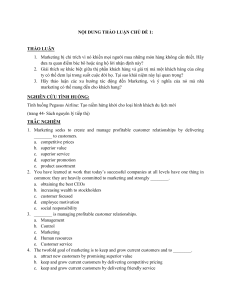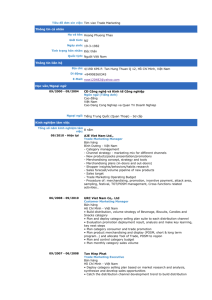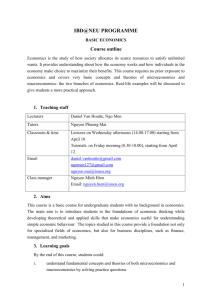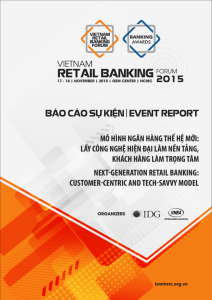A Feature Attributes
advertisement
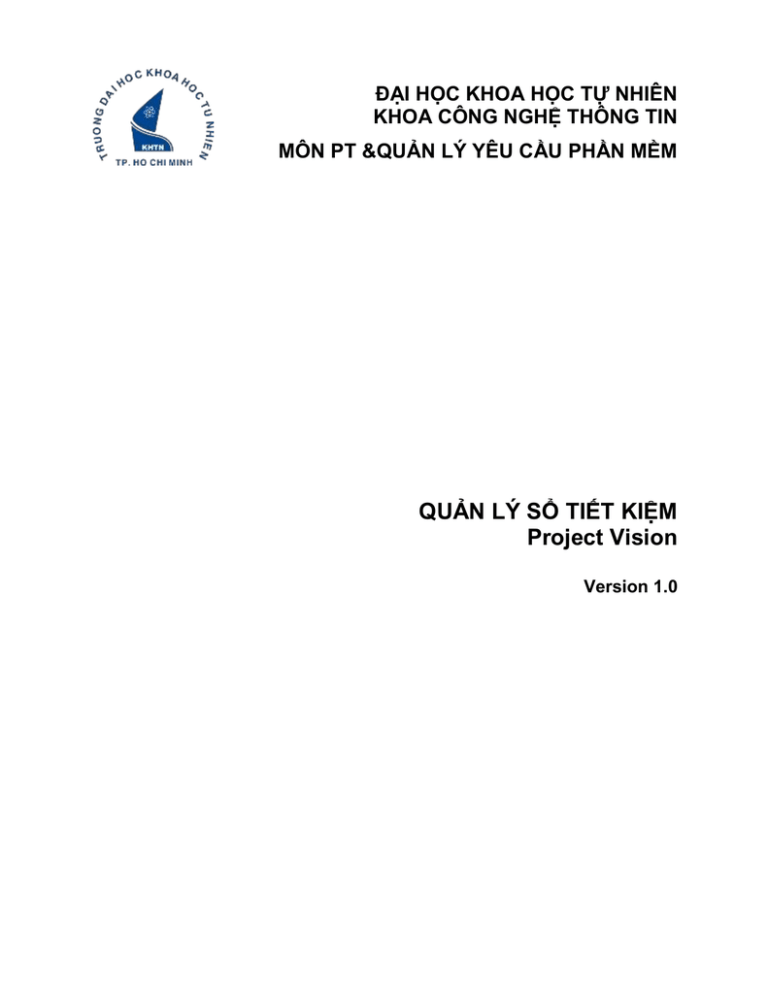
ĐẠI HỌC KHOA HỌC TỰ NHIÊN KHOA CÔNG NGHỆ THÔNG TIN MÔN PT &QUẢN LÝ YÊU CẦU PHẦN MỀM QUẢN LÝ SỔ TIẾT KIỆM Project Vision Version 1.0 QUẢN LÝ SỔ TIẾT KIỀM Vision 000001 Version: 1.0 Date: 18/11/2012 Revision History Date 18/11/2012 Confidential Version <1.0> Description Viễn cảnh của dự án <Company Name>, 2016 Author Nhóm TheBoys Page 2 QUẢN LÝ SỔ TIẾT KIỀM Vision 000001 Version: 1.0 Date: 18/11/2012 Table of Contents 1. 2. 3. Introduction 5 1.1 1.2 1.3 1.4 1.5 5 5 5 5 5 Purpose Scope Definitions, Acronyms, and Abbreviations References Overview Positioning 5 2.1 2.2 2.3 5 5 5 Business Opportunity Problem Statement (Đặt vấn đề) Product Position Statement Stakeholder and User Descriptions 6 3.1 3.2 3.3 3.4 3.5 4. 5. Market Demographics Stakeholder Summary User Summary User Environment Stakeholder Profiles 3.5.1 Nhóm lập trình viên 3.5.2 Nhân viên ngân hàng 3.5.3 Khách hàng 3.6 User Profiles 3.6.1 Nhân viên giao dịch 3.6.2 Nhân viên kiểm soát 3.6.3 Nhân viên thủ quỹ 3.6.4 Khách hàng 3.7 Key Stakeholder or User Needs 3.8 Alternatives and Competition 3.8.1 <aCompetitor> 3.8.2 <anotherCompetitor> 6 6 7 7 8 8 8 8 9 9 9 9 10 10 11 11 11 Product Overview 11 4.1 4.2 4.3 4.4 4.5 11 11 12 12 12 Product Perspective Summary of Capabilities Assumptions and Dependencies Cost and Pricing Licensing and Installation Product Features 12 5.1 5.2 13 13 <aFeature> <anotherFeature> 6. Constraints 13 7. Quality Ranges 13 8. Precedence and Priority 13 Confidential <Company Name>, 2016 Page 3 QUẢN LÝ SỔ TIẾT KIỀM Vision 000001 9. Other Product Requirements 13 9.1 9.2 9.3 9.4 13 13 13 13 10. Applicable Standards System Requirements Performance Requirements Environmental Requirements Documentation Requirements 10.1 10.2 10.3 10.4 A Version: 1.0 Date: 18/11/2012 13 User Manual Online Help Installation Guides, Configuration, and Read Me File Labeling and Packaging Feature Attributes A.1 A.2 A.3 A.4 A.5 A.6 A.7 A.8 Confidential 13 14 14 14 14 Status Benefit Effort Risk Stability Target Release Assigned To Reason 14 14 15 15 15 15 15 15 <Company Name>, 2016 Page 4 QUẢN LÝ SỔ TIẾT KIỀM Vision 000001 Version: 1.0 Date: 18/11/2012 Vision 1. Introduction 1.1 Purpose Mục đích của tài liệu Vision này là thu thập, phân tích và xác định những nhu cầu và chức của phần mềm “Quản lý sổ tiết kiệm”. Tài liệu này tập trung vào các khả năng cần thiết cho bên liên quan và người dùng, mục tiêu và cũng như nguyên nhân ra đời của phần mềm. Tài liệu giúp đội ngũ phát triển có cái nhìn tổng quan về phần mềm và hướng phát triển phần mềm trong tương lai. Đồng thời tài liệu này còn là “Kim Chỉ Nam ” cho đội ngũ phát triển xây dựng phần mềm đúng hướng và thành công. 1.2 Scope Tài liệu được áp dụng cho website “Quản lý sổ tiết kiệm” được phát triển bởi nhóm “TheBoys”, nhằm hỗ trợ khách hàng gửi tiền tiết kiệm vào ngân hàng, khách hàng có thể truy vấn tiền gửi có kỳ hạn và không có kỳ hạn, có thể chủ động xem thông tin chi tiết số dư và giao dịch tài khoản tiền gửi của mình cũng như việc quản lý ngân hàng. 1.3 Definitions, Acronyms, and Abbreviations 1.4 References 1.5 Overview 2. Positioning 2.1 Business Opportunity Cùng với sự phát triển của kinh tế, xã hội nhu cầu của con người ngày càng cao. Để tạo sự thuận tiện cho khách hàng các ngân hàng đã cho ra đời hình thức tiết kiệm trục tuyến mà chỉ cần một cú click chuột, bạn đã tự tạo cho mình một tài khoản tiết kiệm có kỳ hạn, bằng cách dễ dàng chuyển những khoản tiền nhàn rỗi tích luỹ từ tài khoản vãng lai sang tài khoản tiết kiệm. Khách hàng có thể quản lý và kiểm tra tài khoản của mình bất cứ khi nào mà không cần phải đến ngân hàng, điều này tiết kiệm rất nhiều thời gian và chi phí đi lại. 2.2 Problem Statement (Đặt vấn đề) 2.3 The problem of Hiện tại ngân hàng chưa có chương trình để hỗ trợ cho việc quản lý sổ tiết kiệm. affects Khách hàng, ngân hàng. the impact of which is Khách hàng có thể quản lý và kiểm tra tài khoản của mình bất cứ khi nào mà không cần phải đến ngân hàng. Ngân hàng có thể cũng tiết kiệm được thời gian thay vì phải phục vụ khách hàng thì bây giờ nhân viên có thể rảnh rỗi hơn, ngân hàng không cần phải thuê nhiều nhân viên điều này tiết kiệm chi phí cho ngân hàng. a successful solution would be Tạo sư thuận tiện tiết kiệm thời gian chi phí cho cả ngân hàng và khách hàng. Product Position Statement Confidential <Company Name>, 2016 Page 5 QUẢN LÝ SỔ TIẾT KIỀM Vision 000001 Version: 1.0 Date: 18/11/2012 For Khách hàng Who Khách hàng có nhu cầu gửi tiền tiết kiệm vào ngân hàng The (product name) Web site “Quản lý sổ tiết kiệm” dịch vụ Internet banking That Có thể quản lý tốt hệ thống quản lý sổ tiết kiệm, đỡ tốn chi phí và công sức của ngân hàng Unlike Our product 3. Stakeholder and User Descriptions [To effectively provide products and services that meet your stakeholders’ and users' real needs, it is necessary to identify and involve all of the stakeholders as part of the Requirements Modeling process. You must also identify the users of the system and ensure that the stakeholder community adequately represents them. This section provides a profile of the stakeholders and users involved in the project, and the key problems that they perceive to be addressed by the proposed solution. It does not describe their specific requests or requirements as these are captured in a separate stakeholder requests artifact. Instead, it provides the background and justification for why the requirements are needed.] 3.1 Market Demographics Đồ án chỉ được thực hiện cho Ngân Hàng XYZ. 3.2 Stakeholder Summary Name Description Responsibilities Project Manager Quản lý điều hành dự án Khảo sát, lập kế hoạch, kiểm soát và thực hiện dự án. Business Analyst Người chịu trách nhiệu gặp khách hàng để thu thập yêu cầu. Thu thập yêu cầu khách hàng Đặc tả yêu cầu. Kiểm nghiệm yêu cầu. Mô hình hóa yêu cầu. Designer Chịu trách nhiệm thiết kế hệ thống. Thiết kế kiến trúc. Thiết kế dữ liệu. Thiết kế giao diện. Thiết kế xử lý. Deverloper Cài đăt mã nguồn Triển khai cài đặt dựa trên các thiết kế có sẵn. Tester Kiểm nghiệm phần mềm Kiểm tra phát hiện lỗi. So sánh phân tích thiết kế. Kiểm thử các chức năng chạy có đúng với bản thiết kế hay không. Ngân hàng ABC Nhóm đưa ra yêu cầu phát triển dự án. Kiểm tra đánh giá và liên tục nhận báo cáo từ nhóm phát triển phần mềm. Nhân viên Ngân Người trực tiếp sử dụng Thực hiện các nghiêp vụ ngân hàng thông qua Confidential <Company Name>, 2016 Page 6 QUẢN LÝ SỔ TIẾT KIỀM Vision 000001 hàng Version: 1.0 Date: 18/11/2012 (tương tác) hệ thống hệ thống quản lý 3.3 User Summary [Present a summary list of all identified users.] Name Description Responsibilities Stakeholder Người quản trị (Admin) Quản trị hệ thống Phân quyền hề thống. Ngân hàng ABC Nhóm người dùng (User) Nhân viên quản lý Quản lý thông tin nhân viên. Phân quyên cho tài khoản của nhóm người dùng và Khách hàng. Ngân hàng ABC Thống kê giao dịch. Thống kê sổ tiết kiệm. Thống kê doanh thu. Thay đổi quy định. Quản lý các chi nhánh. Nhân viên giao dịch Mở sổ, đóng sổ cho khách hàng. Ngân hàng ABC Xem thông tin sổ tiết kiệm của ngân hàng. Thực hiện giao dịch với khách hàng như: nạp tiền vào sổ, rút sổ. Tìm kiếm khách hàng, chi nhánh Nhân viên kiểm soát Quản lý các phiên giao dịch (quyết định chấp nhận hay không chấp nhận giao dịch). Giao dịch phải thông qua nhân viên kiểm soát. Ngân hàng ABC Nhận viên thủ quỹ Nhận thông tin từ giao dịch và thực hiện thu chi Ngân hàng ABC Khách hàng Xem thông tin cá nhân. Khách hàng Xem lịch sử giao dịch. Tìm kiếm chi nhánh gần nhà nhất. 3.4 User Environment Số người dự kiến tham gia dự án: 5 người. Tổng số giờ dự kiến cho 1 người: 2 (giờ) * 24(ngày)*3 (tháng) = 144 (giờ). Giao diện web. Ngôn ngữ sử dụng: C#, asp.net. Nền tảng: Framework.Net 4.0 Kiến trúc 3 Layer. Hệ quản trị CSDL SQL Server. Confidential <Company Name>, 2016 Page 7 QUẢN LÝ SỔ TIẾT KIỀM Vision 000001 Version: 1.0 Date: 18/11/2012 3.5 Stakeholder Profiles 3.5.1 Nhóm lập trình viên Representative Project Manager, Business Analyst, Designer, Deverloper, Tester. Description Nhóm chịu trách nhiệm phát triển dự án. Type Có kinh nghiệp chuyên môn về nghiệp vụ Ngân hàng có khả năng hoàn thành tốt dự án Responsibilities Khảo sát, lập kế hoạch, kiểm soát và thực hiện dự án. Success Criteria Dự án phải hoàn tất. Thỏa 3 tính chất ràng buộc: - Xác định đúng phạm vi. - Định lượng được thời gian. - Ước lượng được chi phí. Involvement Deliverables Comments / Issues 3.5.2 Nhân viên ngân hàng Representative Nhân viên ngân hàng Description Người dùng Type Có kiến thức chuyên môn về nghiệp vụ Ngân. Responsibilities Thực hiện các giao dịch cho khách hàng. Success Criteria Thực hiện nhanh chóng và chính xác các giao dịch. Involvement Deliverables Comments / Issues 3.5.3 Khách hàng Representative Khách hàng Description Người dùng. Type Người có nhu cầu gửi tiết kiệm tại ngân hàng. Responsibilities Thực hiện các công việc truy vấn thông tin cá nhân. Success Criteria Xem kết quả nhanh chóng và chính xác. Involvement Deliverables Confidential <Company Name>, 2016 Page 8 QUẢN LÝ SỔ TIẾT KIỀM Vision 000001 Version: 1.0 Date: 18/11/2012 Comments / Issues 3.6 User Profiles 3.6.1 Nhân viên giao dịch Representative Nhân viên giao dịch. Description Làm công việc mở sổ cho khách hàng, xem thông tin sổ tiết kiệm của khách hàng, thực hiện giao dịch với khách hàng như nạp tiền vào sổ, đóng sổ. Tìm kiếm chi nhánh. Type Nhân viên ngân hàng Responsibilities Giao dịch và làm việc với khách hàng. Success Criteria Giao dịch nhanh chóng và độ chính xác cao. Involvement Deliverables Comments / Issues 3.6.2 Nhân viên kiểm soát Representative Nhân viên kiểm soát Description Làm công việc kiểm soát các phiên giao dịch, chấp nhận hay không chấp nhận giao dịch, 1 giao dịch thành công phải có xác nhận của nhân viên kiểm soát. Type Nhân viên ngân hàng Responsibilities Tiếp nhận thông tin giao dịch từ nhân viên giao dịch và xét duyệt. Success Criteria Giao dịch nhanh chóng và độ chính xác cao. Involvement Deliverables Comments / Issues 3.6.3 Nhân viên thủ quỹ Representative Nhân viên thủ quỹ Description Làm công việc thu, chi tiền. Confidential <Company Name>, 2016 Page 9 QUẢN LÝ SỔ TIẾT KIỀM Vision 000001 Version: 1.0 Date: 18/11/2012 Type Nhân viên ngân hàng Responsibilities Tiếp nhận thông tin giao dịch từ nhân viên giao dịch và đã có sự chấp nhận của nhân viên kiểm soát. Success Criteria Giao dịch nhanh chóng và độ chính xác cao. Involvement Deliverables Comments / Issues 3.6.4 Khách hàng Representative Khách hàng Description Có thể thực hiện: Xem thông tin cá nhân, Xem thông tin các sổ tiết kiệm và lịch sử giao dịch. Xem thông tin lãi suất, tìm kiếm chi nhánh. Type Khách hàng. Responsibilities Tìm kiếm, xem thông tin nhanh và chính xác. Success Criteria Involvement Deliverables Comments / Issues 3.7 Key Stakeholder or User Needs Need Priority Concerns Tính bảo mật Cao Bảo mật thông tin khách hàng, tài khoản. Mã hóa mật khẩu, mật khẩu không dưới 8 kí tự, khách hàng phải đăng nhập khi vào hệ thống. Hệ thống chạy ổn định Cao Hoạt động 24/7. Chọn Host tốt đường truyền, băng thông phù hợp có khả năng chạy liện tục. Dễ bảo trì mở rộng Cao Có thể mở rộng thêm nhiều lĩnh vực hoạt động. Các chức năng được cài đặt tốt có khả tăng tái sử dụng và mở rộng thêm khi cần thiết (Ngân hàng thay dổi chính sách, nghiệp vụ, mở rộng thêm) Phản hồi nhanh (dưới 5 giây) Cao Khi người dùng tương tác với hệ thống, hệ thống sẽ gửi phản hồi Băng thông tốt có thể đáp ứng được lượng truy cập lớn. Confidential Current Solution <Company Name>, 2016 Proposed Solutions Page 10 QUẢN LÝ SỔ TIẾT KIỀM Vision 000001 Version: 1.0 Date: 18/11/2012 trước dưới 5 giây. Giao diện dễ sử dụng Cao Giao diện dễ dùng cho người dùng lần đầu tiên sử dụng. Thiết kế giao diện thân thiện dễ dùng, dễ thay đổi giao diện khi cần. 3.8 Alternatives and Competition [Identify alternatives the stakeholder perceives as available. These can include buying a competitor’s product, building a homegrown solution or simply maintaining the status quo. List any known competitive choices that exist or may become available. Include the major strengths and weaknesses of each competitor as perceived by the stakeholder or end user.] 3.8.1 <aCompetitor> 3.8.2 <anotherCompetitor> 4. Product Overview [This section provides a high level view of the product capabilities, interfaces to other applications, and system configurations. This section usually consists of three subsections, as follows: • Product perspective • Product functions • Assumptions and dependencies] 4.1 Product Perspective [This subsection of the Vision document puts the product in perspective to other related products and the user’s environment. If the product is independent and totally self-contained, state it here. If the product is a component of a larger system, then this subsection needs to relate how these systems interact and needs to identify the relevant interfaces between the systems. One easy way to display the major components of the larger system, interconnections, and external interfaces is with a block diagram.] 4.2 Summary of Capabilities [Summarize the major benefits and features the product will provide. For example, a Vision document for a customer support system may use this part to address problem documentation, routing, and status reporting without mentioning the amount of detail each of these functions requires. Organize the functions so the list is understandable to the customer or to anyone else reading the document for the first time. A simple table listing the key benefits and their supporting features might suffice. For example:] Confidential <Company Name>, 2016 Page 11 QUẢN LÝ SỔ TIẾT KIỀM Vision 000001 Version: 1.0 Date: 18/11/2012 Table 4-1 Customer Benefit New support staff can quickly get up to speed. Customer satisfaction is improved because nothing falls through the cracks. Management can identify problem areas and gauge staff workload. Distributed support teams can work together to solve problems. Customers can help themselves, lowering support costs and improving response time. Customer Support System Supporting Features Knowledge base assists support personnel in quickly identifying known fixes and workarounds. Problems are uniquely itemized, classified and tracked throughout the resolution process. Automatic notification occurs for any aging issues. Trend and distribution reports allow high level review of problem status. Replication server allows current database information to be shared across the enterprise. Knowledge base can be made available over the Internet. Includes hypertext search capabilities and graphical query engine. 4.3 Assumptions and Dependencies [List each of the factors that affect the features stated in the Vision document. List assumptions that, if changed, will alter the Vision document. For example, an assumption may state that a specific operating system will be available for the hardware designated for the software product. If the operating system is not available, the Vision document will need to change.] 4.4 Cost and Pricing [For products sold to external customers and for many in-house applications, cost and pricing issues can directly impact the application’s definition and implementation. In this section, record any cost and pricing constraints that are relevant. For example, distribution costs, (# of diskettes, # of CD-ROMs, CD mastering) or other cost of goods sold constraints (manuals, packaging) may be material to the projects success, or irrelevant, depending on the nature of the application.] 4.5 Licensing and Installation [Licensing and installation issues can also directly impact the development effort. For example, the need to support serializing, password security or network licensing will create additional requirements of the system that must be considered in the development effort. Installation requirements may also affect coding or create the need for separate installation software.] 5. Product Features [List and briefly describe the product features. Features are the high-level capabilities of the system that are necessary to deliver benefits to the users. Each feature is an externally desired service that typically requires a series of inputs to achieve the desired result. For example, a feature of a problem tracking system might be the ability to provide trending reports. As the use-case model takes shape, update the description to refer to the use cases. Because the Vision document is reviewed by a wide variety of involved personnel, the level of detail needs to be general enough for everyone to understand. However, enough detail must be available to provide the team with the information they need to create a use-case model. To effectively manage application complexity, we recommend for any new system, or an increment to an existing system, capabilities are abstracted to a high enough level so 25-99 features result. These features provide the fundamental basis for product definition, scope management, and project management. Each feature will be expanded in greater detail in the use-case model. Confidential <Company Name>, 2016 Page 12 QUẢN LÝ SỔ TIẾT KIỀM Vision 000001 Version: 1.0 Date: 18/11/2012 Throughout this section, each feature will be externally perceivable by users, operators or other external systems. These features need to include a description of functionality and any relevant usability issues that must be addressed. The following guidelines apply: • Avoid design. Keep feature descriptions at a general level. Focus on capabilities needed and why (not how) they should be implemented. • If you are using the Rational RequisitePro toolkit, all need to be selected as requirements of type for easy reference and tracking.] 5.1 <aFeature> 5.2 <anotherFeature> 6. Constraints [Note any design constraints, external constraints or other dependencies.] 7. Quality Ranges [Define the quality ranges for performance, robustness, fault tolerance, usability, and similar characteristics that are not captured in the Feature Set.] 8. Precedence and Priority [Define the priority of the different system features.] 9. Other Product Requirements [At a high level, list applicable standards, hardware or platform requirements, performance requirements, and environmental requirements.] 9.1 Applicable Standards [List all standards with which the product must comply. These can include legal and regulatory (FDA, UCC) communications standards (TCP/IP, ISDN), platform compliance standards (Windows, UNIX, and so on), and quality and safety standards (UL, ISO, CMM).] 9.2 System Requirements [Define any system requirements necessary to support the application. These can include the supported host operating systems and network platforms, configurations, memory, peripherals, and companion software.] 9.3 Performance Requirements [Use this section to detail performance requirements. Performance issues can include such items as user load factors, bandwidth or communication capacity, throughput, accuracy, and reliability or response times under a variety of loading conditions.] 9.4 Environmental Requirements [Detail environmental requirements as needed. For hardware- based systems, environmental issues can include temperature, shock, humidity, radiation, and so forth. For software applications, environmental factors can include usage conditions, user environment, resource availability, maintenance issues, and error handling and recovery.] 10. Documentation Requirements [This section describes the documentation that must be developed to support successful application deployment.] 10.1 User Manual [Describe the purpose and contents of the User Manual. Discuss desired length, level of detail, need for index, glossary of terms, tutorial versus reference manual strategy, and so on. Formatting and printing constraints must also Confidential <Company Name>, 2016 Page 13 QUẢN LÝ SỔ TIẾT KIỀM Vision 000001 Version: 1.0 Date: 18/11/2012 be identified.] 10.2 Online Help [Many applications provide an online help system to assist the user. The nature of these systems is unique to application development as they combine aspects of programming (hyperlinks, and so forth) with aspects of technical writing, such as organization and presentation. Many have found the development of an online help system is a project within a project that benefits from up-front scope management and planning activity.] 10.3 Installation Guides, Configuration, and Read Me File [A document that includes installation instructions and configuration guidelines is important to a full solution offering. Also, a Read Me file is typically included as a standard component. The Read Me file can include a "What's New With This Release” section, and a discussion of compatibility issues with earlier releases. Most users also appreciate documentation defining any known bugs and workarounds in the Read Me file.] 10.4 Labeling and Packaging [Today's state-of-the-art applications provide a consistent look and feel that begins with product packaging and manifests through installation menus, splash screens, help systems, GUI dialogs, and so on. This section defines the needs and types of labeling to be incorporated into the code. Examples include copyright and patent notices, corporate logos, standardized icons and other graphic elements, and so forth.] A Feature Attributes [Features are given attributes that can be used to evaluate, track, prioritize, and manage the product items proposed for implementation. All requirement types and attributes need to be outlined in the Requirements Management Plan, however, you may wish to list and briefly describe the attributes for features that have been chosen. The following subsections represent a set of suggested feature attributes.] A.1 Status [Set after negotiation and review by the project management team. Tracks progress during definition of the project baseline.] Proposed [Used to describe features that are under discussion but have not yet been reviewed and accepted by the "official channel," such as a working group consisting of representatives from the project team, product management, and user or customer community.] Approved [Capabilities that are deemed useful and feasible, and have been approved for implementation by the official channel.] Incorporated [Features incorporated into the product baseline at a specific point in time.] A.2 Benefit [Set by Marketing, the product manager or the business analyst. All requirements are not created equal. Ranking requirements by their relative benefit to the end user opens a dialog with customers, analysts, and members of the development team. Used in managing scope and determining development priority.] Confidential <Company Name>, 2016 Page 14 QUẢN LÝ SỔ TIẾT KIỀM Vision 000001 Version: 1.0 Date: 18/11/2012 Critical [Essential features. Failure to implement means the system will not meet customer needs. All critical features must be implemented in the release or the schedule will slip.] Important [Features important to the effectiveness and efficiency of the system for most applications. The functionality cannot be easily provided in some other way. Lack of inclusion of an important feature may affect customer or user satisfaction, or even revenue, but release will not be delayed due to lack of any important feature.] Useful [Features that are useful in less typical applications will be used less frequently or for which reasonably efficient workarounds can be achieved. No significant revenue or customer satisfaction impact can be expected if such an item is not included in a release.] A.3 Effort [Set by the development team. Because some features require more time and resources than others, estimating the number of team or person-weeks, lines of code required or function points, for example, is the best way to gauge complexity and set expectations of what can and cannot be accomplished in a given time frame. Used in managing scope and determining development priority.] A.4 Risk [Set by development team based on the probability the project will experience undesirable events, such as cost overruns, schedule delays or even cancellation. Most project managers find categorizing risks, as high, medium, and low, is sufficient, although finer gradations are possible. Risk can often be indirectly assessed by measuring the uncertainty (range) of the projects team’s schedule estimate.] A.5 Stability [Set by the analyst and development team, this is based on the probability that features will change or the team’s understanding of the feature will change. Used to help establish development priorities and determine those items for which additional elicitation is the appropriate next action.] A.6 Target Release [Records the intended product version in which the feature will first appear. This field can be used to allocate features from a Vision document into a particular baseline release. When combined with the status field, your team can propose, record, and discuss various features of the release without committing them to development. Only features whose Status is set to Incorporated and whose Target Release is defined will be implemented. When scope management occurs, the Target Release Version Number can be increased so the item will remain in the Vision document but will be scheduled for a later release.] A.7 Assigned To [In many projects, features will be assigned to "feature teams" responsible for further elicitation, writing the software requirements, and implementation. This simple pull-down list will help everyone on the project team to understand responsibilities better.] A.8 Reason [This text field is used to track the source of the requested feature. Requirements exist for specific reasons. This field records an explanation or a reference to an explanation. For example, the reference might be to a page and line number of a product requirement specification or to a minute marker on a video of an important customer review.] Confidential <Company Name>, 2016 Page 15
